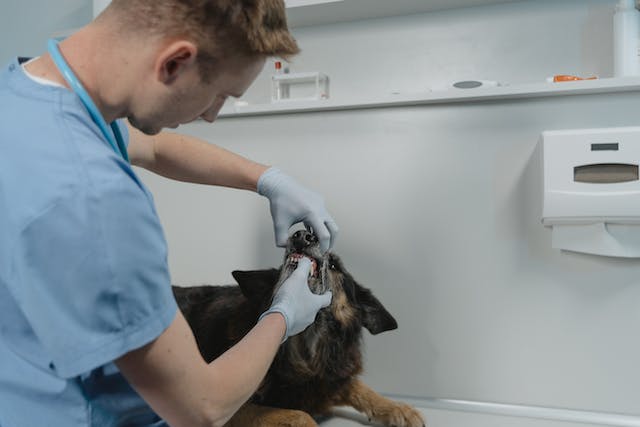Bacteria, viruses, fungi, parasites, tumors, toxins, hormonal problems, cysts, and gallbladder problems can cause liver disease in dogs. By knowing a little more about liver disease symptoms, we can help our furry friends get the help they need on time and increase the chances of them making a thorough recovery.
In this article, we’ll briefly explain the symptoms, stages, prognosis, and treatment for liver disease in dogs.
Disclaimer: Please refer to the information in this article as a guide only. If you want specific information tailored to your pet’s condition, contact your veterinarian.
What are the stages of liver disease in dogs?
To understand the symptoms of liver diseases in dogs, let’s first take a look at how it can be classified into 4 stages (source).
Stage 1
In this stage, your dog’s liver responds to a stimulus their immune system detects to be harmful, such as those we listed earlier. This results in what’s called an ‘inflammatory response’ where different cells and components start working to try and overcome the disease.
The inflammatory response is often the reason why a dog suffers from non-specific symptoms such as nausea, increased temperature, and lethargy. In this stage, a vet can usually prescribe medication to help them feel better by relieving these symptoms.
Stage 2
After the inflammatory response has time to progress, scars form in the liver and characterize the second stage. If the disease is diagnosed in this stage then it could be reversible.
Stage 3
After more time has passed, these scars become permanent, and as they start to interfere with the normal functioning of the liver, and lead to the final stage.
Stage 4
In this stage, the scars disturb the normal functioning of the liver and mean it fails to perform its vital functions.
How do I know if my dog has liver problems?
Liver disease can be either acute (occurring suddenly) or chronic (when it progresses slowly over a longer period). In both cases, the signs can vary a lot depending on what’s behind the disease.
You can read about how liver disease is diagnosed by a veterinarian in this article.
It’s also good to know that diseases in your dog’s liver can also be related and have an impact on other organs such as their heart, lungs, brain, and kidneys. This is often related to the decreased breakdown of toxins by the liver and decreased production of important blood components.
Signs that your dog could have a problem with its liver can vary according to a variety of factors such as the type of problem, the stage of liver disease, and your dog’s age and their general condition.
To give you a general idea, we’ve listed some examples of some symptoms that can occur due to liver disease below:
- Yellow color in their skin, gums, and eyes.
- Vomiting and nausea.
- Neurological symptoms.
- Swollen belly.
- Eye problems.
- Bleeding.
- Changes in weight, appetite, urination, and drinking habits.
It’s always best to contact your veterinarian as soon as you think there could be something wrong with your pet. Early diagnosis increases the chances of your pet making a thorough recovery and getting back to normal as soon as possible.
How long can a dog live with liver disease?
The prognosis of a dog with liver disease depends on a few factors, such as:
- How far has the disease progressed?
- Whether it’s responsive to treatment.
- Your dog’s general condition and the severity of their symptoms.
When thinking about your pet’s health, it’s best to consider their quality of life when making decisions regarding their treatment and to discuss all the options with your veterinarian.
The HHHHHMM scale is a helpful resource that you can use to estimate your pet’s quality of life.
What is the best medicine for a dog’s liver?
The best medicine for a dog with liver disease depends on the cause of the disease, which we talked about earlier and can include:
- Supportive care such as fluids or special food.
- Antibiotics in the case of a bacterial infection.
- Targeted therapies aimed at specific symptoms.
Can you reverse liver failure in dogs?
The possibility of reversing liver disease in dogs depends on factors such as:
- What caused the failure in the first place
- How progressed the liver failure is (liver disease can be reversible up to stage 2).
- Your dog’s response to previous treatment.
- Your dog’s health condition.
The possibility of treating conditions in your pet is often much higher when they are diagnosed early on. It’s always best to seek advice from a veterinarian as soon as you notice something wrong with your pet.
How can I naturally heal my dog’s liver?
It’s always better to prevent diseases in pets rather than cure them, as far as possible. If you think that something is wrong with your pet, it’s best to take them to a veterinarian for a proper diagnosis and treatment plan rather than trying to heal them at home by yourself.
Your veterinarian may perform diagnostics such as blood tests, ultrasound examinations, and X-rays to help find out what is causing the problem in your pet. This will help determine the best type of treatment for their condition and help get them feeling themselves again.
The possibility to naturally heal a dog’s liver largely depends on the reason behind the disease in the first place. To help keep your dog healthy, we’d recommend the following:
- Vaccinating your dog and keeping the boosters up to date.
- Treating your dog for endo and ectoparasites regularly. You can read more about this in our article Flea and tick prevention tips recommendations for dog owners.
- Take your dog for a yearly check-up with your veterinarian.
- Feeding your dog a high-quality diet in the appropriate amounts and exercising them regularly to help them maintain the appropriate weight.
You can read more about hours to help your dog be as happy and healthy as possible in our article How to take care of a dog for their good health: a comprehensive guide and The benefits of a comprehensive dental care plan for dogs.
Conclusion
Liver disease in dogs can be a worrying topic for pet parents. After reading this article, we hope that you have some information to help you spot potential problems early on, and increase the chances of your dog having a thorough recovery.

Charlotte qualified as a veterinarian in 2023 and has been working as a writer for several years helping pet parents understand how to help their pets live happy healthy lives whilst pursuing her interests in wildlife conservation.
She enjoys traveling and has undertaken positions in Belgium, Spain, Austria, Germany, and the Galapagos and has a 15-year-old rescue dog called Chiki.





